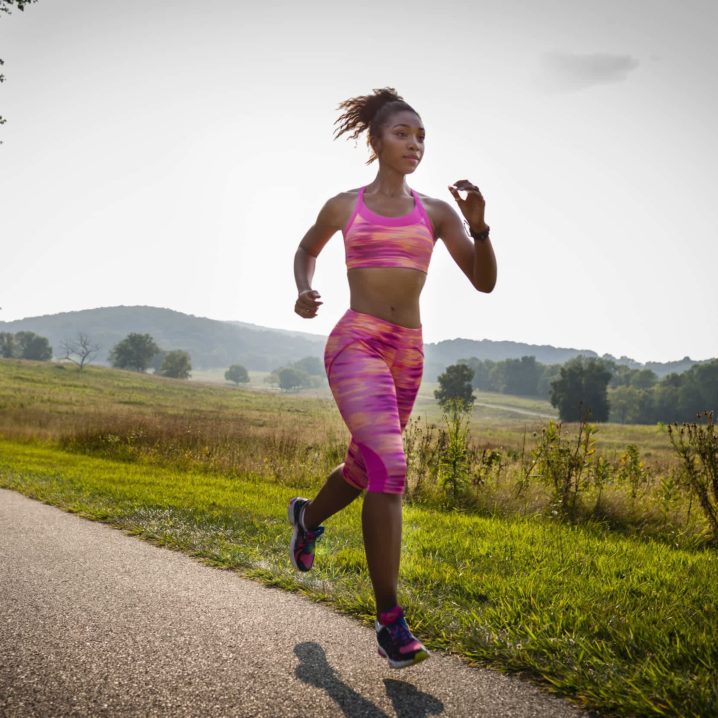
- POPSUGAR Australia
- Fitness
- 3 Tips For Soothing Sore Feet After a Long Run, According to a Running Coach
3 Tips For Soothing Sore Feet After a Long Run, According to a Running Coach

After the euphoric runner’s high wears off, I often feel the physical aftermath of my long morning runs in my feet – tender aches in my arches and general soreness near my toes. The discomfort usually disappears by the early afternoon, but the loop begins again at sunrise.
The good news: I may be able to edit this exercise storyline by following the advice of Amber Harris, an ACE-certified personal trainer and RRCA-certified running coach.
Stretch After Your Run
As a rule, Harris actually says stretching your feet after a long run isn’t necessary, but if you’re having issues or dealing with soreness, stretching could help the issue. I tried Harris’s recommended post-run stretches below, and felt a much-needed tension release in my feet.
Toes on the Wall Stretch
- Standing with toes of the right foot up against a wall, push forward until you feel the stretch in your right calf. Hold for 10-20 seconds at a time, and then switch sides.
- Repeat 2-3 times on each side.
Butt to Heel Stretch
- Start in a quadruped position with knees directly beneath the hips and palms on the floor, with wrists directly under the shoulders.
- With your toes curled under and into the floor, push your hips back toward your heels.
- You should feel a stretch in the soles of your feet.
- Hold for 10-20 seconds at a time as comfort allows.
- Repeat 2-3 times.
Self Massage
- Sitting in a chair, press the left foot into the floor with knee at 90-degree angle, and bring the right ankle on top of the left knee.
- Using your thumbs, gently massage the sole of your right foot, increasing pressure as comfort allows.
- If you find any knots, try to work those out gently.
- Repeat on the left foot.
Another feel-good trick perfect for a hot summer day? “You could roll a frozen water bottle underneath your feet to help ease any inflammation you might be having post-run.”
Related: The Ultimate Beginner’s Guide to Running: 20 Tips Every Runner Needs to Know
Add Strengthening Exercises to Your Warmup
Instead of speeding through my warmup so I can hit the pavement as soon as possible, I’m going to spend a little more time preparing my body for the work ahead – and adding strengthening exercises into my pre-run routine, as recommended by Harris.
“I would just pick two at a time from the following, and switch to the other two for your next long run – until you figure out which combo works best for you.”
Toe Scrunches
- Sitting in a chair with feet flat, place the edge of a hand towel under the toes of your right foot and scrunch the towel up using your toes, bringing it toward your chair.
- Repeat steps on the left foot.
- Repeat 3-5 times on each foot.
Big Toe/Little Toe Lifts
- From a standing position, press the big toe on each foot into the floor and lift the four little toes on each foot.
- Then, press the four little toes into the floor while lifting the big toe on each foot.
- Perform 5-10 repetitions of each.
Using a Trigger Point Massage Ball or Generic Lacrosse Ball
- Gently roll the ball underneath the sole of your foot. If you find a tight spot, work the ball back and forth gently to release any tension.
Foam Rolling Your Calves
“Many times the feet feel tight because the calves are tight,” Harris says.
- Sitting on the floor with legs extended, place a foam roller underneath your calves and roll back and forth.
- Gently massage back and forth on any tight spots in the calves.
- To increase the intensity, you can place the heel of the right foot onto the left toes and roll out your left calf and then switch sides.
Related: Training For a Time Goal? Keep These 3 Running Tips in Mind
Switch Up Your Running Shoes
“Sore feet – and/or joints – can definitely be a sign that it is time for new shoes,” Harris says. How do you figure out if your shoes are expired? Harris says that, depending on the shoe brand and model, running shoes should last anywhere from 300-500 miles.
“I recommend tracking the miles on your shoes – many apps, like Garmin Connect and Strava, have that feature for you.”
Harris also suggests investing in two pairs of running shoes and rotating between them when training. “It makes your shoes last longer, giving the foam 24-48 hours to fully decompress between runs. Rotating shoes appropriate for your running gait can vary the load of running just enough to assist in preventing injury. Please, please, please get yourself assessed at your local running store.”
Click here for more health and wellness stories, tips, and news.

